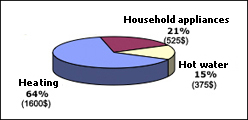Did you know that for the average house, up to 40% of heat loss is caused by air leaks? On a typical energy bill, it can amount to more than $700. That's your money going out the window simply because the house wasn't air tight enough. From now on, think tight. Not only do weatherstripped leaks have a positive effect on your energy bill, they also affect your comfort. When cold air seeps into your house, some rooms can become filled with uncomfortable air drafts and are impossible to heat up. If your house isn't air tight enough there might be condensation on your windows and walls, even mildew. Weatherstripping can make a world of difference!
To learn more about the many ways you can optimize your energy consumption, visit the "Mieux consommer" residential diagnostic section of the Hydro-Québec website. This interactive tool will provide you with energy and money saving tips.
References: "Agence de l'efficacité énergétique" and Canada's Natural Resources


